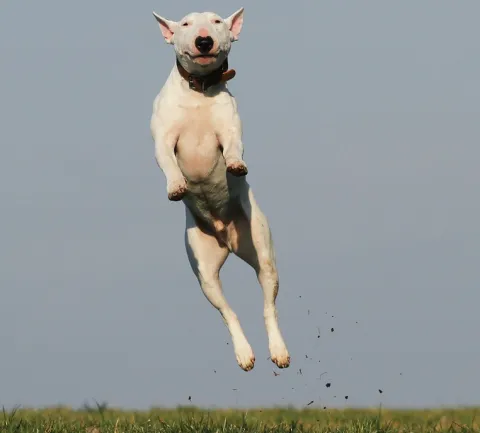Inappropriate jumping is arguably one of the most common and frustrating behavioral challenges dog owners face. Whether your canine companion greets you with a joyous leap or bounds at houseguests, this behavior can be both embarrassing and potentially unsafe, especially with larger dogs. Understanding the root causes and implementing consistent, positive training strategies are key to teaching your dog more appropriate ways to interact. Just as we learn to manage various aspects of canine behavior, such as training a dog to walk on a leash without pulling, addressing jumping requires patience and a clear approach.
Understanding Why Your Dog Jumps
To effectively stop your dog from jumping up, it’s crucial to understand the motivations behind this behavior. For the vast majority of dogs, two primary factors drive jumping: a desire for attention and inadvertent training.
Attention-Seeking and Inadvertent Training
Dogs are social creatures that crave interaction. When your dog jumps, they are often attempting to engage with you or your visitors at eye level, seeking to be included in the conversation or activity. This is particularly noticeable when guests arrive; as your attention shifts to your visitors, your dog may feel overlooked and resort to jumping as a means to regain your focus. From their perspective, any attention – even a reprimand – is better than being ignored.
Furthermore, many puppies learn early on that jumping, particularly balancing on their hind legs, garners a response. This might initially be positive reinforcement, like fuss or treats, as people mistakenly believe the puppy is performing a cute trick. As dogs mature, this behavior can persist. Even if owners start to shout, the act of shouting still provides attention, reinforcing the jumping behavior. Inconsistency from owners, where jumping is accepted in some situations but not others, further confuses dogs, who struggle to differentiate acceptable contexts.
Aggression: A Rare but Serious Cause
While uncommon, there is a third, more serious reason a dog might jump: aggression. If a dog displays clear warning signs such as raised hackles, growling, or a tucked tail, and these signals are ignored, they might escalate to mock attacks that could be mistaken for jumping. In these instances, the dog may show teeth, growl, and potentially snap. This is an extremely rare and dangerous situation that demands immediate professional intervention.
Ultimately, whether driven by a bid for attention, learned behavior, or a misunderstood defensive signal, jumping up is an unacceptable behavior that needs to be addressed for the safety and comfort of everyone, particularly as your dog grows larger.
Actionable Steps to Prevent Jumping
Stopping a dog from jumping up requires a clear strategy focused on positive reinforcement and consistent communication. Punishing your dog for jumping is never the answer; it can lead to confusion, fear, and potentially aggressive behavior. Instead, redirect their energy towards more desirable actions.
When Aggression is a Concern
If you suspect your dog is jumping due to aggression, displaying warning signs such as growling, snapping, or other threatening postures, it is imperative to stop immediately and consult a qualified canine behaviorist. This is a serious situation that requires expert professional guidance to ensure the safety of your dog and others.
Positive Reinforcement: Diverting to a “Sit” Command
For most cases, where jumping stems from excitement or attention-seeking, the first effective method is to redirect the behavior into an appropriate action, such as a “sit” command. As your dog becomes excited and starts to jump, calmly give the “sit” command. Once they comply, reward them immediately with praise, a gentle pat, or a small treat. This teaches your dog that sitting earns them positive attention, while jumping does not. Consistent practice, ideally with the help of friends who can act as regular “visitors,” will solidify this association. When addressing different training challenges, such as if your dog pulls on the leash and chokes, a similar approach of redirection and reward is often highly effective.
 A dog jumping up excitedly at a person's leg, demonstrating the common behavior being addressed
A dog jumping up excitedly at a person's leg, demonstrating the common behavior being addressed
The Power of Ignoring and Rewarding Stillness
Another highly effective technique, which can be used alone or in conjunction with the “sit” command, is to completely ignore your dog when they jump. This means turning your back, avoiding eye contact, and refraining from speaking to them. The moment all four of their paws are on the floor, immediately reward them with attention, praise, or a treat. This teaches your dog that jumping yields no attention, but keeping their feet on the ground does. This strategy reinforces the idea that calm, four-on-the-floor greetings are the desired behavior. If you’re wondering how to train a dog to stop leash pulling, similar principles of ignoring unwanted behavior and rewarding desired actions apply. This method is universal; it works not just with you but also when new people are around.
Conclusion
Teaching your dog to stop jumping up requires patience, consistency, and a commitment to positive reinforcement. By understanding why your dog jumps and applying these humane training methods, you can help them learn appropriate ways to greet people. The effort is well worth it, preventing potentially awkward or even dangerous situations with guests. Remember, every dog is different, and some may require more time and practice than others. If you find yourself struggling, or if the behavior escalates, don’t hesitate to contact a qualified canine behaviorist. They can provide tailored advice and support, helping you train your dog to stop pulling or address any other behavioral challenge, ensuring a harmonious relationship between you and your beloved companion. With dedication, you can train a dog from pulling when walking and effectively stop them from jumping.
